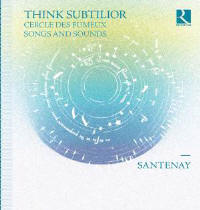Texte paru dans: / Appeared in: |
|
|
Outil de traduction ~ (Très approximatif) |
|
|
Reviewer: Barry
Brenesal Allan W. Atlas, in his Renaissance Music, gave as good an explanation of the late 14th-century Ars subtilior movement as I’ve ever read or heard. He noted its dense rhythmic complexity, a matter of both voice against voice with different mensurations that aren’t identical to time signatures, and extremely complex syncopation within any given part. Atlas also referred to the movement’s high instance of unprepared dissonance, sometimes perhaps as a tool of expressiveness, but just as often for reasons that appear to be pure delight in experimentation. Ars subtilior compositions generated great interest and heavy patronage for roughly half a century, at such diverse courts as Aragón, Avignon, Foix, Nicosia, and Paris, before fading away. Albums of this music, unfortunately, have always been hard to come by, though some distinguished ensembles—among them Alla Francesca, Gothic Voices, and Paul Van Nevel’s Huelgas Ensemble—have issued releases of the music. Given the relative paucity of Ars subtilior releases, then, I was immediately intrigued when this new release appeared with Santenay, a performing group I’d never encountered before. The four-person ensemble consists of Elodie Wiemer, recorder; Szilárd Chereji, vielle, Orí Harmelin, lute; and Julla von Landsberg, who both sings and plays portative organ. Her voice is a pleasant lyric soprano, capable of some agile displays in Hasprois’s Puisque je sui fumeux, and with an upper register that sacrifices enunciation for brightness. All instrumentalists perform capably, with Harmelin getting a solo in an intabulation of Solage’s Fumeux fume par fumee. Their ability to make good music out of the dense notational thickets of these works is praiseworthy, and they manage it without recourse to musical anachronisms. And yet, for all that I greatly enjoyed both music and musicians on this release, there are three major caveats that need to be mentioned up front. First, this is the kind of album that would have been considered of reasonable length back in the LP era, but not since. A timing of just over 51 minutes in 13 cuts, though short enough, is not even truly representative, since five of those cuts that total 7:30 are consumed by ensemble-composed, semi-electronic pieces referred to as “sonic atmospheres.” These all have titles without capitalization (“haze,” “emanation,” etc.), and have less to do with 14th-century musical experimentation than the radio program of New Age music Hearts of Space. That’s not a criticism, but a statement of fact. That takes us to a second issue with this release: Santenay’s attempt to set the Ars subtilior composers and music within a framework of electronica, presumably under the assumption that this complex music must be filtered through a “long ago and far, far away” prism to attract an audience. Not only does it appear in the interludes I’ve mentioned, but for over 10 seconds beyond the conclusions of both the original and intabulated versions of Solage’s Fumeux fume par fumee. And, 48 seconds into an instrumental version of Ciconia’s Le ray au soleyl, minimalist electronic atmosphere simply stops the piece for 23 seconds, until it recedes and the music returns once more. Finally, this disc concentrates on already recorded works of the Ars subtilior, especially Solage’s Fumeux (which we hear twice, if admittedly in two texturally distinct versions), rather than the large number of surviving pieces from this school that are exceptional in their quality, and are currently unavailable on disc.
What makes
all this poignant is that Santenay evinces an excellent grasp of the
prevailing performance practices during this period. For fanciers of this
music, it isn’t likely to prove enough. | |
|
Support us financially by purchasing this disc from eiher one of these suppliers. Un achat via l'un ou l'autre des fournisseurs proposés contribue à défrayer les coûts d'exploitation de ce site. |
|
|
|
|
|
Cliquez l'un ou l'autre
bouton pour découvrir bien d'autres critiques de CD |
|




